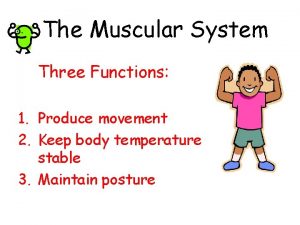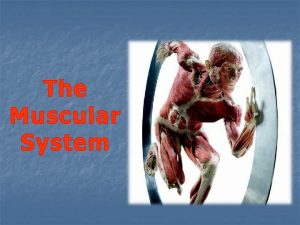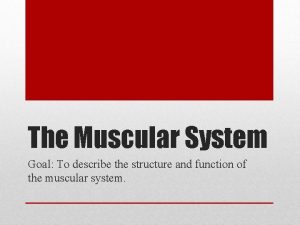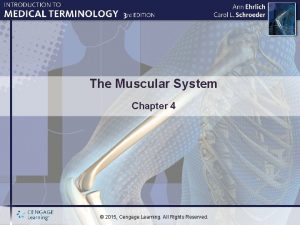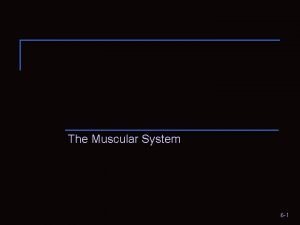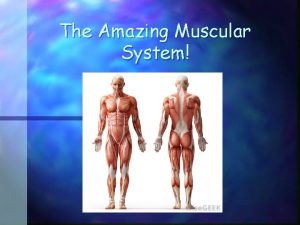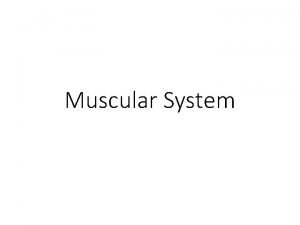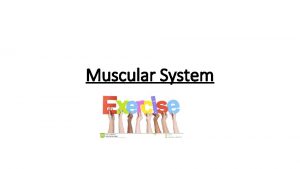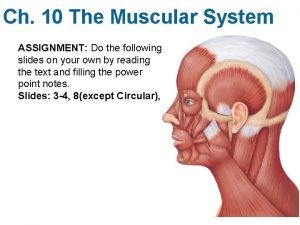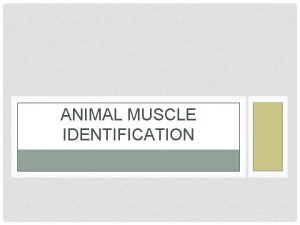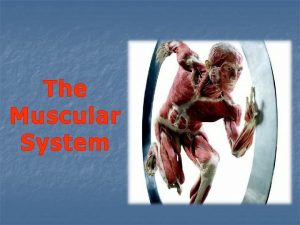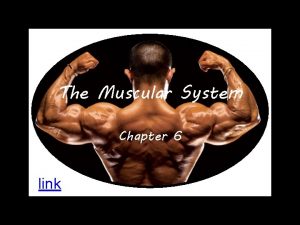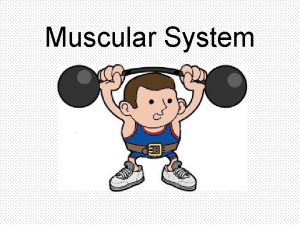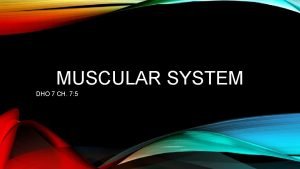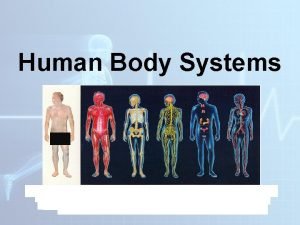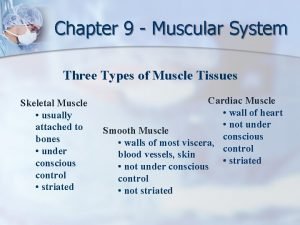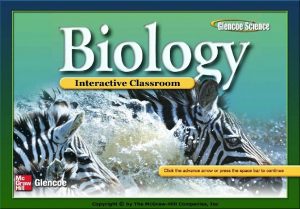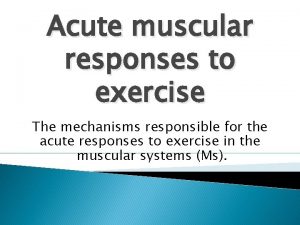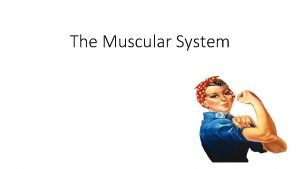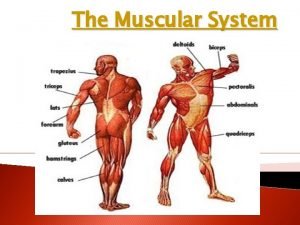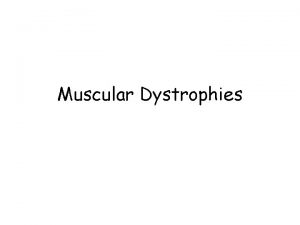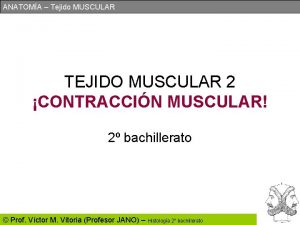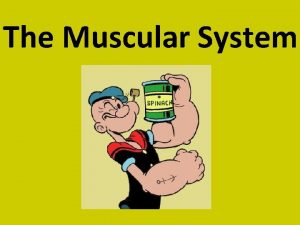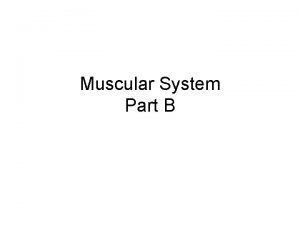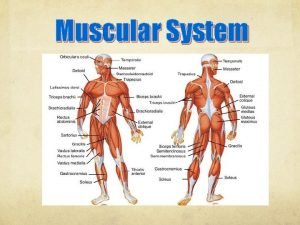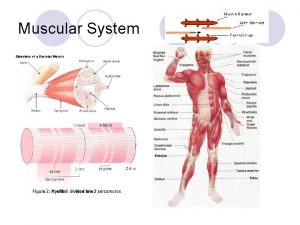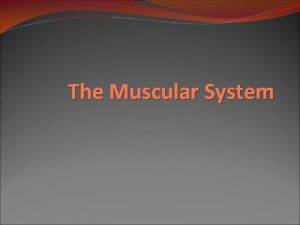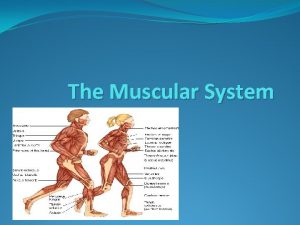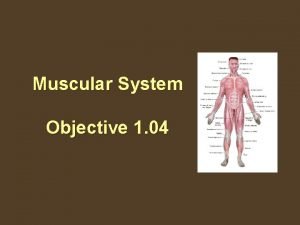6 The Muscular System PART A Power Point





























- Slides: 29

6 The Muscular System PART A Power. Point® Lecture Slide Presentation by Jerry L. Cook, Sam Houston University ESSENTIALS OF HUMAN ANATOMY & PHYSIOLOGY EIGHTH EDITION ELAINE N. MARIEB Copyright © 2006 Pearson Education, Inc. , publishing as Benjamin Cummings

Function of Muscles • Produce movement • Maintain posture • Stabilize joints • Generate heat

The Muscular System • Muscles are responsible for all types of body movement • Three basic muscle types are found in the body • Skeletal muscle • Cardiac muscle • Smooth muscle

Characteristics of Muscles • Muscle cells are elongated (muscle cell = muscle fiber) • Contraction of muscles is due to the movement of microfilaments • All muscles share some terminology • Prefix myo refers to muscle • Prefix mys refers to muscle • Prefix sarco refers to flesh

Skeletal Muscle Characteristics • Most are attached by tendons to bones • Cells are multinucleate • Striated – have visible banding • Voluntary – subject to conscious control • Cells are surrounded and bundled by connective tissue

Connective Tissue Wrappings of Skeletal Muscle • Endomysium – around single muscle fiber • Perimysium – around a fascicle (bundle) of fibers Figure 6. 1

Connective Tissue Wrappings of Skeletal Muscle • Epimysium – covers the entire skeletal muscle • Fascia – on the outside of the epimysium Figure 6. 1

Skeletal Muscle Attachments • Epimysium blends into a connective tissue attachment • Tendon – cord-like structure • Aponeuroses – sheet-like structure • Sites of muscle attachment • Bones • Cartilages • Connective tissue coverings

Smooth Muscle Characteristics • Has no striations • Spindle-shaped cells • Single nucleus • Involuntary – no conscious control • Found mainly in the walls of hollow organs Figure 6. 2 a

Cardiac Muscle Characteristics • Has striations • Usually has a single nucleus • Joined to another muscle cell at an intercalated disc • Involuntary • Found only in the heart Figure 6. 2 b

Naming of Skeletal Muscles • Direction of muscle fibers • Example: rectus (straight) • Relative size of the muscle • Example: maximus (largest)

Naming of Skeletal Muscles • Location of the muscle • Example: many muscles are named for bones (e. g. , temporalis) • Number of origins • Example: triceps (three heads) Origin: attachment to bone that does NOT move Insertion: attachment to bone that MOVES

Naming of Skeletal Muscles • Location of the muscle’s origin and insertion • Example: sterno (on the sternum) e • Shape of the muscle • Example: deltoid (triangular) • Trapezius (trapezoid shaped) • Action of the muscle • Example: flexor and extensor (flexes or extends a bone)

Microscopic Anatomy of Skeletal Muscle • Cells are multinucleate • Nuclei are just beneath the sarcolemma Figure 6. 3 a

Microscopic Anatomy of Skeletal Muscle • Sarcolemma – specialized plasma membrane • Sarcoplasmic reticulum – specialized smooth endoplasmic reticulum Figure 6. 3 a

Microscopic Anatomy of Skeletal Muscle • Myofibril • Bundles of myofilaments • Myofibrils are aligned to give distinct bands • I band = light band • A band = dark band Figure 6. 3 b

Microscopic Anatomy of Skeletal Muscle • Sarcomere • Contractile unit of a muscle fiber Figure 6. 3 b

Microscopic Anatomy of Skeletal Muscle • Organization of the sarcomere • Thick filaments = myosin filaments • Composed of the protein myosin • Has ATPase enzymes Figure 6. 3 c

Microscopic Anatomy of Skeletal Muscle • Organization of the sarcomere • Thin filaments = actin filaments • Composed of the protein actin Figure 6. 3 c

Microscopic Anatomy of Skeletal Muscle • Myosin filaments have heads (extensions, or cross bridges) • Myosin and actin overlap somewhat Figure 6. 3 d

Microscopic Anatomy of Skeletal Muscle • At rest, there is a bare zone that lacks actin filaments • Sarcoplasmic reticulum (SR) – for storage of calcium Figure 6. 3 d

Properties of Skeletal Muscle Activity • Irritability – ability to receive and respond to a stimulus • Contractility – ability to shorten when an adequate stimulus is received • Animation of muscle contraction

muscles must Nerve • Skeletal Stimulus to Muscles be stimulated by a nerve to contract • Motor unit • One neuron • Muscle cells stimulated by that neuron Figure 6. 4 a

Nerve Stimulus to Muscles • Neuromuscular junctions – association site of nerve and muscle Figure 6. 5 b

cleft –to gap. Muscles Nerve • Synaptic Stimulus between nerve and muscle • Nerve and muscle do not make contact • Area between nerve and muscle is filled with interstitial fluid Figure 6. 5 b

Transmission of Nerve Impulse to Muscle • Neurotransmitter – chemical released by nerve upon arrival of nerve impulse • The neurotransmitter for skeletal muscle is acetylcholine • Neurotransmitter attaches to receptors on the sarcolemma • Sarcolemma becomes permeable to sodium (Na+)

Transmission of Nerve Impulse to Muscle • Sodium rushing into the cell generates an action potential • Once started, muscle contraction cannot be stopped

The Sliding Filament Theory of Muscle Contraction • Activation by nerve causes myosin heads (crossbridges) to attach to binding sites on the thin filament • Myosin heads then bind to the next site of the thin filament Figure 6. 7

The Sliding Filament Theory of Muscle Contraction • This continued action causes a sliding of the myosin along the actin • The result is that the muscle is shortened (contracted) Figure 6. 7
 Difference between strength and endurance
Difference between strength and endurance Power triangle diagram
Power triangle diagram Powerbi in powerpoint
Powerbi in powerpoint Point point power
Point point power Power angle curve in power system stability
Power angle curve in power system stability Three functions of the muscular system
Three functions of the muscular system Whats the function of the muscular system
Whats the function of the muscular system 5 functions of muscular system
5 functions of muscular system Chapter 4 the muscular system labeling exercises
Chapter 4 the muscular system labeling exercises Unit 6:5 muscular system
Unit 6:5 muscular system Amazing facts about the muscular system
Amazing facts about the muscular system Word root for muscle
Word root for muscle Muscular system label
Muscular system label The muscular system chapter 6
The muscular system chapter 6 Muscular system head and neck
Muscular system head and neck Brachiocephalicus
Brachiocephalicus Navigating the body skeletal system #1
Navigating the body skeletal system #1 Whats the function of the muscular system
Whats the function of the muscular system Chapter 6 the muscular system figure 6-12
Chapter 6 the muscular system figure 6-12 Whats in the muscular system
Whats in the muscular system Test chapter 7:5 muscular system
Test chapter 7:5 muscular system Aerobic respiration exercise
Aerobic respiration exercise Structures of the muscular system
Structures of the muscular system Chapter 9 muscular system
Chapter 9 muscular system Chapter 32 section 3 the muscular system answer key
Chapter 32 section 3 the muscular system answer key Muscular system response to exercise
Muscular system response to exercise Whats the muscular system
Whats the muscular system Human body muscles name
Human body muscles name Dorsifelxion
Dorsifelxion Muscular system levels of organization
Muscular system levels of organization





